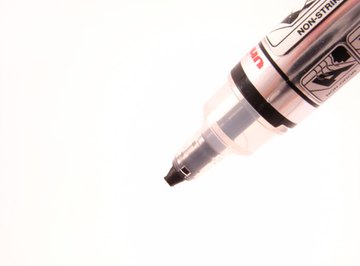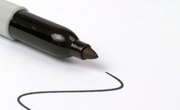
Dry-erase markers have been around, in various forms, since the 1960s. By making small changes in the composition of a permanent marker, manufacturers created an ink that would not be absorbed by a dry-erase board. Dry-erase markers are permanent, however, if used on any surface that absorbs liquids, such as paper or cloth. Three main chemicals are found in dry erase markers: SD alcohol-40, isopropanol and resin.
SD Alcohol-40
Specially denatured alcohol-40 is a form of ethyl alcohol, or ethanol. Ethanol is the type of alcohol used in alcoholic beverages, but is also used in cosmetics, household products and dry-erase markers. When ethyl alcohol is used in non-food products, it is denatured to prevent accidental consumption. The denaturing process requires a chemical called a denaturant to be added to make the taste of the product unappealing. Examples of these chemicals include: denatonium benzoate, quassin and brucine.
Isopropanol
Isopropanol, also known as isopropyl alcohol, is another chemical found in dry-erase markers. Isopropyl alcohol (IPA) is a solvent--a chemical that dissolves other substances and mixes with other solvents easily. IPA is found in many household products, including rubbing alcohol, cleaners, glue, paint and inks. Like most types of alcohol, isopropanol is highly flammable; never expose dry-erase markers to an open flame. Inhaling the fumes of a dry-erase marker can cause both long-term and short-term health hazards, such as irritation to the mucous membranes, confusion and possibly kidney or liver problems.
Resin
Resins are typically derived from plants, and are sticky or solid in their natural state. The resin is alcohol-soluble, and dissolves in contact with the other chemicals in the dry-erase marker. This allows the resin to mix with pigment and flow through the marker. Once exposed to air, the alcohol begins to evaporate, which causes the resin to revert to its original state. Combined with pigment, the resin becomes solid once more, retaining the shape left by the marker.
References
About the Author
Vee Enne is a U.S. Military Veteran who has been writing professionally since 1993. She writes for Demand Studios in many categories, but prefers health and computer topics. Enne has an associate's degree in information systems, and a bachelor's degree in information technology (IT) from Golden Gate University.
Photo Credits
marker image by Eldin Muratovic from Fotolia.com
